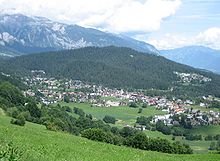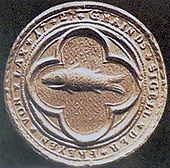Free from Laax
The Free of Laax ( Ils libers da Laax) were a village community above the Flims Forest in what is now Laax . Free , there were also in the field of community Sevgein . The name of the valley Surselva (= above the forest) still gives evidence of the settlement above the large forest of Films.
The origin of the Free from Laax is not clear. It is conceivable that their privileged status goes back to high medieval colonization processes. Settlement by deported Saxons from the Saxon Wars of Charlemagne or by farmers in the wake of monastic settlements cannot be ruled out . If the new settlers were German immigrants, they were quickly and thoroughly Romanized , as the purely Romanic place and field names in Laax show.
The name “Laax” was first mentioned in 1290 in a directory in Chur Cathedral without any reference to the origin of the settlement. The first news about the Free of Laax can be found in a register of Habsburg rights and property that King Albrecht I had drawn up at the beginning of the 14th century. It describes a county and a lordship of Laax in detail. The county of Lags der Free von Laax was built around 1280 and bestowed on the House of Habsburg .
The center of the county of Laax was Lagenberg Castle . In 1323 the castle was conquered and destroyed by Donat von Vaz in a feud : because the vestibule was broken, because it is held by that of Vatz . After Donat's death in 1337, the Lagenberg came into the possession of her husband Rudolf von Werdenberg-Sargans through his sister Ursula von Vaz on May 3, 1342 : the fryen ze Lax vnd with the name waz im ze sinem wip… .
The free were organized as cooperatives or neighborhoods , had the right to own property and were independent of any ruling power. Their county was not a territorial rule, such as the barons of Rhäzüns or the Disentis monastery . It was a judicial community, an association of free people who lived as groups in Laax and the villages of the Surselva.
In 1428 the Free of Laax bought themselves free of the Werdenbergs' rights for 300 gold ducats, in 1434 they joined the Gray League and placed themselves under the protection of the Diocese of Chur as free people of God .
In places where many free people have settled - in the Gruob , on Heinzenberg , in the Schams valley , in Breil / Brigels - one type of family name is particularly common: All of them have the typical Ca- in name for the name of the house or the house power. Examples are Capal (Pal = Paul), Cajochen (Jochen), Cajacob (Jakob), Cahannes (Johannes), Cantieni (Anton) or Cathomas / Cathomen (Thomas).
Web links
- Martin Bundi: Laax (rule). In: Historical Lexicon of Switzerland . November 11, 2008 , accessed December 15, 2018 .
- Martin Bundi: Laax (municipality). In: Historical Lexicon of Switzerland . November 5, 2007 , accessed December 15, 2018 .
- Settlement history of the Tujetsch
literature
- Jürg Simonett (overall editor): Handbuch der Bündner Geschichte . Ed .: Association for Bündner Kulturforschung . tape 1 . Bündner monthly newspaper , Chur 2005, p. 281 .
- Peter Dürrenmatt : Swiss History . tape 1 . NSB, Zurich 1976, p. 51 .
- Alfons Maissen (editor): Laax - A Bündner community . Ed .: Foundation “Pro Laax”. Laax 1978, p. 360 .
Individual evidence
- ^ Peter Dürrenmatt: Swiss History; Zurich 1976; Volume 1, p. 51
- ^ Alfons Maissen: Laax; Laax 1978, p. 22
- ^ Alfons Maissen: Laax; Laax 1978
- ^ County of Laax
- ↑ Clavadetscher / Meyer: Burgenbuch Graubünden, p. 86
- ↑ Handbook on the history of Graubünden, Chur 2005, Volume 1; P. 218
- ^ Alfons Maissen: Laax; Laax 1978, p. 16
- ↑ Cudischet da Laax, Laax 2005



